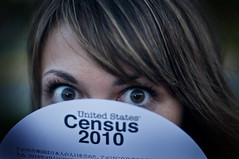 The Sacramento Bee recently reported on a political battle unfolding over the 2010 Census that brings sociologists and demographers center stage. The fight has begun over whether and how to count legal and illegal immigrants in the Census.
The Sacramento Bee recently reported on a political battle unfolding over the 2010 Census that brings sociologists and demographers center stage. The fight has begun over whether and how to count legal and illegal immigrants in the Census.
The context: Senator David Vitter of Louisiana wants only legal citizens to be counted in the Census. Steve Gándola, president and chief executive officer of the Sacramento Hispanic Chamber of Commerce, wants to count all Latinos in the 2010 census, including millions of noncitizens. Meanwhile, Rev. Miguel Rivera, who heads the National Coalition of Latino Clergy and Christian Leaders, wants illegal Latino immigrants to boycott the Census as a way to show their displeasure with Congress’ refusal to overhaul national immigration laws. His motto: “No legalization, no enumeration.”
A sociologist weighs in on the stakes at hand:
With the largest Latino population in the nation, California has a big stake in the debate. The Golden State would lose five of its 53 House seats if noncitizens were not counted, according to a study by Andrew Beveridge, a professor of sociology at Queens College in New York.
Some historical context on the issue:
Citizenship has never been a requirement, dating back to the first census in 1790, when each slave was counted as three-fifths of a person, said Clara Rodriguez, a sociology professor and census expert at Fordham University in New York. “Slaves were not citizens,” she said. “They did not become citizens until after the Civil War.”
Rodriguez sympatheizes with Rev. Rivera’s goals but thinks the effort is misguided:
“I don’t think it’s a good idea,” Rodriguez said. “I think that they’re shooting themselves in the foot. I think if people are here, they should be counted. Whether they’re here in an undocumented fashion or not, you’re here. And most of these people have to work and pay taxes.”
Rodriguez said an organized boycott would just complicate the work of the federal officials who fret about undercounts every 10 years, when the census is conducted. In the past, she said, individuals have decided on their own whether or not to participate.
“The census has had a very hard time in the past getting people to cooperate, for a variety of reasons,” Rodriguez said.
“Some people don’t want to be bothered. Some people don’t want government interference. Some people don’t want to fill out all those forms. They don’t think the government should know all that. And some people don’t want the government to know that they’re here.”



